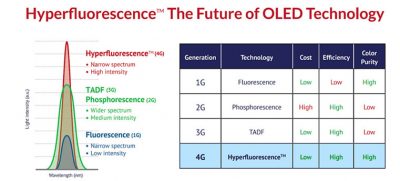Hyperfluorescence™: the most efficient OLED emission technology
Hyperfluorescence™ is an OLED emitting mechanism that combines two different emitter materials – TADF and first-gen fluorescence.
Hyperfluorescence™ is the 4th-generation OLED emitter technology – as it combines several attractive properties: high-efficiency, long lifetime, low material cost and a narrow emission spectrum. HF emitters are also free of any rare metals.
2nd-Gen (Phosphorescence) and 3rd-gen (TADF) OLED emitter technologies feature a 100% IQE, which creates the misconception that their efficiency cannot be improved. However, both Phosphorescence and TADF emitters feature a wide emission spectrum; Hyperfluorescence™, on the other hand, combines 100% IQE with a narrow spectrum. A narrow spectrum translates into higher color purity, meaning that a display can be made with a wider color gamut. With wide-spectrum emitters, to achieve the same color purity would mean to eliminate (filter out) some of the emission, which will reduce the efficiency. With Hyperfluorescence™ emitters, this is not required and so all emitted energy can be used.

In addition to the higher color purity, a narrow spectrum emission also results in higher peak brightness – another advantage for display producers, as this can conserve power (for example in HDR displays) and enable driving the OLED with lower current that would increase efficiency and lifetime. Our researchers recently simulated a green Phosphorescence OLED and a green Hyperfluorescence™OLED, both in top-emission structure. Taking into account the emission spectrum, the peak brightness of the Hyperfluorescence™ OLED is over 60% higher, which results in a 10% higher EQE (External Quantum Efficiency).



